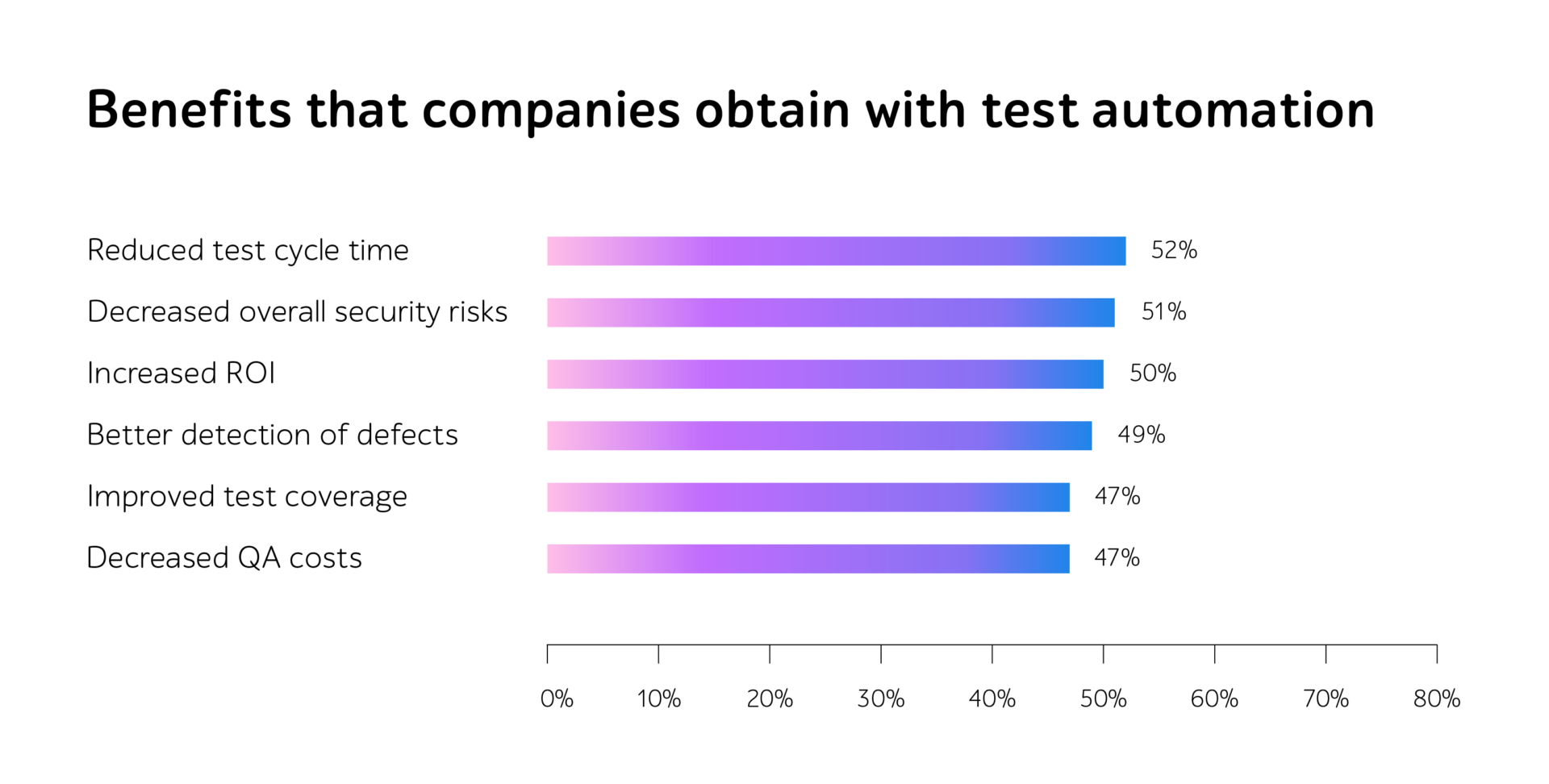In 2021, hackers exposed the personal information of 533 million Facebook users, including phone numbers, full names, birthdays, locations, and bios — all because of a small Facebook failure. This is an example of how missed bugs can become a nightmare for product owners, stakeholders, developers, QA engineers, and, as a result, users.
According to the 2020 “Cost of Poor Software Quality in the US” report, software failures cost US companies $2.08 trillion in 2020. And this is one of the most intimidating consequences, not to mention the higher expenses needed for defect fixing and customers turning to competitors.
However, what are the problems behind the overlooked bugs from the QA side? Let’s reveal them in the article and share the ways to fix them.
Problem #1. No test automation in place
Manual testing is an essential part of every project, but it can’t bring quality results when speed, frequency of tests, and their monotony come to the forefront. After all, the human factor is still there, so teams skip deadlines and find missed defects when the IT product goes live.
How to fix it?
In the long run, automated testing is a way out, helping save efforts on conducting tedious and repetitive tests (like regression). According to the World Quality Report 2021-2022, test automation at the core of a business strategy helps identify bugs faster (49%), improve test coverage (47%), and reduce QA costs (47%). And of course, as 50% of 1,380 agile software delivery experts and influencers point out, adopting test automation provides them with a higher ROI, which is still a predominant business need of many businesses.

Source: World Quality Report 2021-2022
Problem #2. Deadlines, speed, and costs trump software quality
Imagine that the company employees had a goal of releasing a new version of the eCommerce app for Black Friday and Cyber Monday and because of tight deadlines, they decided to skip the testing phase. “What can happen, right?”
As a result, the company lost revenue and the app couldn’t withstand the influx of visitors and crashed. Did it help save money on testing? Of course not.
How to fix it?
Delivering quality at speed is one of the pivotal needs almost of all enterprises, helping adhere to timelines, stay competitive, and maintain top quality of IT solutions. So, what is helpful here?
- Ensuring enough flexibility
Flexible methodologies help shorten development cycles, ensure software update verification from the jump-start, and deliver them swiftly to the IT market. Agility also supports companies in sticking to ever-changing customer expectations and modifying project requirements. According to the 15th State of Agile Report, 64% of surveyed top management representatives highlighted that Agile helped them manage changing priorities, 64% ― accelerate software delivery, 42% ― enhance app quality. Along with that, 35% cut QA costs due to DevOps adoption.
- Shifting to CI/CD
How about detecting bugs in real time and fixing them as they occur? You don’t have to wait and put defect verification away until the last stage. All this is feasible by implementing continuous integration and continuous delivery (CI/CD) within a test automation strategy. The software undergoes changes and updates during its entire lifecycle, and CI/CD facilitates ongoing testing, deployment, and delivery. And all this happens without sacrificing quality ― isn’t that a dream?
- Introducing parallel testing
Let’s look at another example. The deadline is tight, but there is a strong need to test the application across multiple devices and browsers. Not having time, you test only on the latest Google versions. Poor Firefox, Safari, and other users. This is how many bugs are missed.
If you run the tests sequentially, it does take time. However, there is a solution: parallel testing, which allows you to run the same tests simultaneously in different environments. Meanwhile, the QA team can focus its resources on other mission-critical tasks.
Problem #3. Lack of required specialists and skills
Having an in-house QA team is a good option, but is your team big enough to handle the workload, especially during a large-scale project, and do all members have the necessary set of skills?
Let’s imagine that the company has 2 QA specialists in place, and they specialize only in functionality. Of course, defects in performance (such as Flightradar24 platform failure due to heavy loads), cybersecurity (like data leakage in 2021, when the cost of a breach rose to $4.24 million), and more go unnoticed.
How to fix it?
- Onboarding the right in-house team
Since technologies are constantly evolving, QA experts should keep track of the IT environment and topical trends. This helps implement software testing approaches (e.g., shift-left and continuous testing) and methodologies (e.g., Agile and DevOps) as well as apply best practices to solve QA-related challenges of any complexity.
Don’t forget about the time management skills of your team members ― this is what guarantees that the work is going according to the plan and assists in meeting the deadlines.
Even if your team is staffed with QA gurus, ongoing training is still a critical step that involves running specialized seminars and obtaining proficiency in new QA areas.
- Outsourcing software testing
To avoid budget overruns, cut QA costs, and find a perfectly suitable QA team, companies turn to QA outsourcing which is expected to get $425.19 billion by 2026 compared to $318.5 billion in 2020.
When to onboard extra QA experts? Let’s see 4 common cases:
- If you look for an effective and flexible team. Offshore QA specialists are quick to incorporate into your infrastructure, adjust to any request, and easily scale up or down when needed.
- If you want to save time and budget. Independent experts fine-tune QA processes at the very beginning of a project, which facilitates easy and cost-effective defect detection and fixing in the early development stages.
- If you strive to accelerate time to market. A dedicated QA team designs the most optimal QA strategy, which helps speed up the workflows and release the IT product faster.
- If you need to ensure safety standards compliance. An unbiased assessment by offshore professionals allows not only detecting system minor, major, and hidden defects but also assuring the agreement with all relevant global protocols, such as HIPAA, FDA, OWASP, etc.
Bottom line
Missed defects are a nightmare for product owners, developers, and QA engineers.
To avoid this, just be aware of the main problems, leading to bugs in production and how to address them: introduce test automation, use modern approaches (rely on flexible methodologies, shift to CI/CD, conduct parallel testing), and onboard the QA team with the right skillset (internal or dedicated).
In case you need to ensure high quality within your IT products, turn to a1qa’s experts and get professional QA support.
a1qa is a next-gen software testing provider offering a full range of QA services for 19+ years. The clients of a1qa ― global enterprises, including the Fortune 500 companies ― obtain business and operational benefits while reaching the desired outcomes with professional QA. a1qa has successfully delivered 1,500+ projects across various industries: eHealth, eCommerce, telecom, BFSI, M&E, IT and software development, real estate, utilities, and energy, among others.



